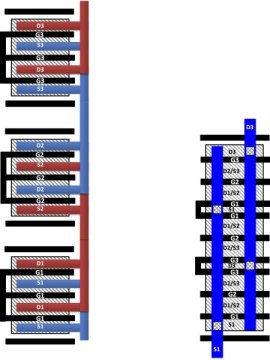Fifth-generation, or 5G, mobile devices are expected to become the norm by 2019, and will require improved power amplifiers operating at very high frequencies. Future phones will be designed to download and transmit data and videos faster than today’s phones, provide better coverage, consume less power, and will meet the needs of an emerging Internet of Things, allowing connected objects to send and receive data.
In order to transmit signals, power amplifiers are needed, and because today’s smartphone amplifiers are made of gallium arsenide, they can’t be integrated into the phone’s silicon-based technology, which is called complementary metal-oxide semiconductor (CMOS). The new amplifier is CMOS-based, meaning it allows researchers to integrate the power amplifier with the phone’s electronic chip, reducing manufacturing costs and power consumption while also boosting performance.

The diagram above shows the standard layout of transistors in smartphone power amplifiers, on the left, and a new highly efficient amplifier design, on the right. Image source: Purdue University.
“Silicon is much less expensive than gallium arsenide, more reliable, has a longer lifespan, and if you have everything on one chip it's also easier to test and maintain,” said Saeed Mohammadi, an associate professor of electrical and computer engineering at Purdue University. “We have developed the highest efficiency CMOS power amplifier in the frequency range needed for 5G cell phones and next-generation radars.”
The amplifier achieves an efficiency of 40%, which is comparable to amplifiers made of gallium arsenide. Researchers created the new amplifier using a high-performance type of CMOS technology called silicon on insulator (SOI). The new design includes several silicon transistors stacked together and reduces the number of metal interconnections normally needed between transistors, reducing parasitic capacitance, which hinders performance and can lead to damage to electronic circuits.
“We have merged transistors so we are using less metallization around the device, and that way we have reduced the capacitance and can achieve higher efficiencies,” Mohammadi said. “We are trying to eliminate metallization between transistors.”
These new amplifiers could introduce low-cost collision-avoidance radars for cars and electronics for lightweight communications microsatellites. Currently researchers are working on a new version of the amplifier that is twice as powerful. Of course, further work will be needed to integrate the amplifier into a smartphone chip.
Source: Purdue University
Advertisement
Learn more about Electronic Products Magazine





